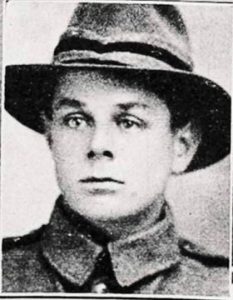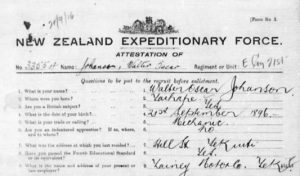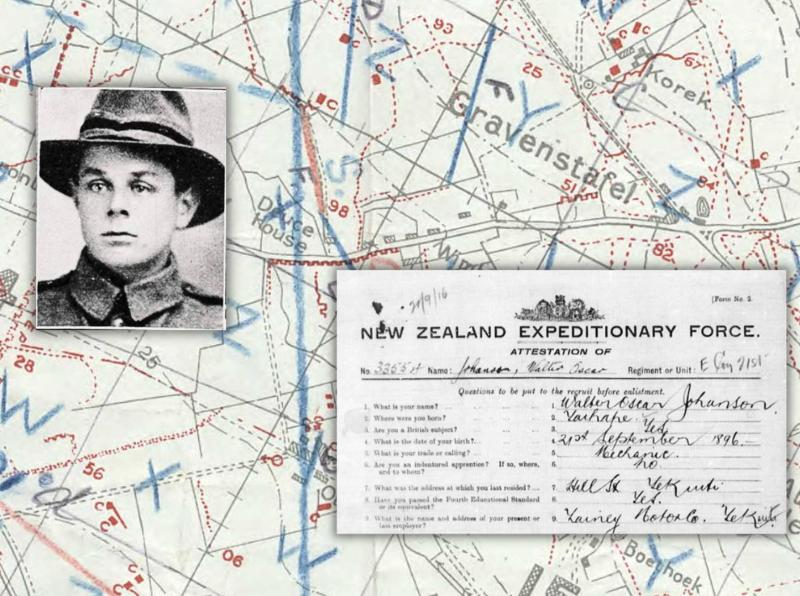Researching an ANZAC ancestor’s military service during WWI: his story and legacy
New Zealander Walter Oscar Johanson answered his country’s call and left his homeland to serve during World War I (WWI), never to return. Over 100 years later, his great-nephew and Forces War Records community member Matt W. took the same journey to visit his ANZAC ancestor’s final resting place on the Western Front. We explore Matt’s journey and Walter’s moving story; perhaps it will inspire you to research your ancestor’s military service.
War is declared
When Britain declared war on Germany on 4 August 1914, nobody in New Zealand could have predicted the war’s impact on the country. Despite being thousands of miles from the main theatre of war on the Western Front, New Zealanders served en masse at home and overseas. Locations such as Gallipoli, the Somme and Passchendaele would become familiar household names, carved into the nation’s military history. The sacrifice made by the ANZACs (Australian and New Zealand Army Corps) at Gallipoli and the ANZAC spirit and legacy displayed during WWI would define both nations and help to foster a national identity. On 25 April each year, the anniversary of the ANZAC’s landing on the Gallipoli peninsula on 25 April 1915, AZNAC Day is marked in Australia and New Zealand with events including a Dawn service. Veterans, service personnel, and the public join in a day of commemoration to recognise the service and sacrifices of all Australians and New Zealanders in wars and conflicts since WWI. Indeed, 120,000 New Zealanders, including Maori and Pacific Islanders, enlisted during WWI, with 100,000 serving overseas. Around 18,000 are said to have lost their lives during or as a result of the war, including Matt’s great-uncle, Walter Oscar Johanson.

Walter Oscar Johanson (1898-1917)
‘I was honoured to be the first member of our family to have the opportunity to visit his grave site. It was a very moving experience, more than I expected.’ – Matt W., Walter’s great-nephew.
Many families know stories of their ancestors’ military service, handed down from generation to generation. Some of us discover these stories when delving into our family history, unearthing a grandparent or a great-aunt/uncle with a connection to the war. Matt came to learn of Walter through the research of his sister Lisa, who was exploring their family tree on Ancestry.
Walter Oscar Johanson was born in Taihape, on New Zealand’s North Island, in 1898, the youngest of ten children born to Aron and Matilda Johansen (more on the name derivative later). Walter’s mother was English, while his father, who died in 1913, was a Swedish settler who found work in New Zealand as a farmer. Before enlisting, Walter was employed as a mechanic with Lainey Motor Company in Te Kuiti. The advent of WWI would change Walter’s life forever. We learned so much about Walter’s military service through his service record, available as part of our WWI New Zealand service record collection. Keep reading to discover what we found.
FWR Tip: Whether you’re researching an ancestor from New Zealand, the UK, Canada or Australia, their service record is a great source for exploring their military service and understanding their wartime experiences. Discover your ancestors’ service records with Forces War Records today.
Walter goes to war
Walter joined up in the autumn of 1916, completing a medical examination in Te Kuiti. His service record provides an insightful physical description, noting he was 5 foot 10 ½ inches tall and weighing 144 pounds. After his medical exam, Walter travelled to Trentham, in the Wellington region of New Zealand, where he enlisted in the New Zealand Expeditionary Force (NZEF) on 20 September. Established in 1914, Trentham Military Camp trained New Zealand soldiers for service in WWI.
There were more intriguing clues buried in Walter’s service record. Studying Walter’s attestation record closely, a crucial point stood out: he gave his date of birth as 21 September 1896, suggesting he enlisted the day before his 20th birthday. We know his birth was registered in 1898; if he was born on 21 September 1898, he was really enlisting the day before his 18th birthday. It wasn’t uncommon for soldiers to lie about their age during WWI, and this may be something your ancestors did, too. Many feared missing out on the action before the war was over. Crucially, for Walter, the minimum age for service in the NZEF at this point was 20 years old, which is probably why he made himself older on enlistment. He also enlisted under the name ‘Johanson’ instead of ‘Johansen’. The advantages of joining up outside your birthplace are evident; recruiters may not be familiar with your date of birth or know you intimately.

FWR Tip: In the UK, soldiers could enlist into the regular army at 18 but were not permitted to serve overseas until they were 19; this was lowered to 18 and a half in March 1918. It is worth bearing this in mind when researching your ancestor’s military service during WWI.
Walter’s enlistment came against the backdrop of a historic moment in New Zealand. On 1 August 1916, the Military Service Act was passed, meaning anyone between the ages of 20 and 45 could be called up for service at home or overseas. Names were selected through a monthly ballot, the first of which was held in November 1916.
Walter’s journey begins
After Walter enlisted, he undertook basic training to mould him into the kind of soldier required by the NZEF. He remained in New Zealand until 19 January 1917, when, as part of the 21st Reinforcements, he departed Wellington aboard the ship Ulimaroa for England. The voyage was not without danger: Germany had declared unrestricted submarine warfare in a region around the British Isles in February 1917, which had a disastrous impact on Allied shipping.
FWR Tip: Some soldiers created magazines or newspapers during their voyage, containing valuable information about day-to-day life and the passengers on board. You may find a digitised copy online when researching your ancestor’s military service.
Although his journey to England was not subject to enemy attack, Walter injured his back and spent three days in the ship’s hospital. The Ulimaroa docked in Devonport, England, on 27 March, and the following day, the 21st Reinforcements made the 140-mile journey to Sling Camp in Bulford, located on the Salisbury Plain in Wiltshire. From mid-1916, Sling was the main base where New Zealand soldiers trained for service on the Western Front.
After two months of training and preparation, Walter and his comrades were finally deemed ready for service on the Western Front, departing for France on 26 May 1917. While attached to the strength of the Base Depot in Etaples, where soldiers awaited posting to a unit, Walter was admitted to Number 24 General Hospital in Etaples on 2 June. He was suffering from influenza, the pandemic that would claim the lives of millions during the following year. Described in his service record as ‘progressing favourably’, Walter was later admitted to Convalescence Depots in Etaples and later Cayeux before rejoining the Base Depot in mid-July.
FWR Tip: When studying your ancestor’s military service record (New Zealand, UK, Australia and Canada), look out for the ‘Casualty Form – Active Service‘. This section will help you piece together their movements and form a timeline of their service.
Walter had achieved his goal of joining the NZEF and had reached the Western Front, treading the path of many other ANZACs. He would soon be thrown into action, but he and his comrades could never have predicted the events that awaited them.
Stay tuned for Part II, where we follow Walter’s journey to the infamous Passchendaele battlefields.
Cover image credit: © Archives New Zealand (service record), The National Archives (trench map), Matt Wilcock (photo of Walter).
Sources
Ancestry, New Zealand, Civil Registration Birth Index, 1840-1902.
Ancestry, New Zealand, Cemetery Records, 1800-2007.
New Zealand WW100, History Guide, accessed April 2024.
New Zealand History, The Gallipoli campaign, accessed April 2024.
New Zealand History, Recruiting and Conscription, accessed April 2024.
New Zealand History, First World War laws and regulations, accessed April 2024.
New Zealand History, First World War military formations, accessed April 2024.
NZ Army, Trentham Military Camp, accessed April 2024.


